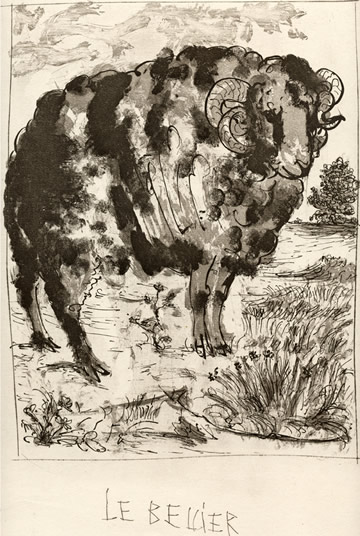 This print is one of
31 different animal images created by Picasso
between 1936 and 1942. The original copper plates from which the
etchings were created used a technique called sugarlift and
drypoint. The etchings were intended to illustrate the Natural
History book of Buffon (Histoire Naturelle), originally
published between 1749 and 1788. Georges-Louis Leclerc Comte de
Buffon was a natural history scientist who lived from 1707-1788.
The 36 volumes of Buffon classified the animal species based on
patterns and details observed as an autonomous science free of
theological influences. His empirical methods contributed
significantly to novel ideas about the distribution of plants and
animals around the globe. Enjoy this summary on Buffon: http://www.strangescience.net/buffon.htm.
This print is one of
31 different animal images created by Picasso
between 1936 and 1942. The original copper plates from which the
etchings were created used a technique called sugarlift and
drypoint. The etchings were intended to illustrate the Natural
History book of Buffon (Histoire Naturelle), originally
published between 1749 and 1788. Georges-Louis Leclerc Comte de
Buffon was a natural history scientist who lived from 1707-1788.
The 36 volumes of Buffon classified the animal species based on
patterns and details observed as an autonomous science free of
theological influences. His empirical methods contributed
significantly to novel ideas about the distribution of plants and
animals around the globe. Enjoy this summary on Buffon: http://www.strangescience.net/buffon.htm.
Buffon and
Picasso were similar in that they did not conform to traditional ways
of thinking. They questioned and pursued their own directions
without regard to traditions and the practices and thoughts of others.
Picasso's
publisher, Ambroise Vollard, proposed to Picasso his creating the
illustrations for new book illustrating Buffon's volumes but Vollard
died in 1939 before the book was completed. Picasso's printer,
Roger Lacourière, printed Picasso-drawn plates in 1941-42.
It was Lacourière who taught Picasso the technique of adding
aquatint to the sugar which when added to the etching plate created
tonal qualities of varying grays. Vollard's associate, Martin
Fabiani, undertook to finish the project and is considered its
publisher. Twenty-one of the 31 plates are accompanied by text of
the Buffon natural history.
Of the 31 animal
images created by Picasso, Saper Galleries has available 9 of the
etchings. Please contact us to see images of the horse, dog, lion,
monkey, vulture, bee, lizard, and frog.
Steel facing
is a modern technique whereby the soft copper plate into which the
image is
etched receives a thin coat of steel via electroplating in order to
harden its
surface. In this way an edition can be printed from beginning to end
without
degradation of image quality, unlike Rembrandt etchings, for example,
whose
bare copper plates wore down from the pressure of the press over the
course of
printing an edition. This resulted in a visible softening of lines, as
well as
a diminishing of subtle contrasts and tonal depth in examples from late
in a
print run. Although steel facing allows for consistent quality
throughout an
edition and is thus an improvement over a bare copper plate, the
process
necessarily reduces textural delicacy and tonal depth to some degree.
Therefore, proofs before steel facing are the ultimate vehicles for
displaying
both the full expressive capacity of the etching process and in so
doing that
of the artist's hand.
Sugar aquatint or
lift-ground etching was mastered by Picasso in 1936. The etching
technique preserves the artist's brushwork and permits broad areas of
color instead of just thin, dry lines.
Picasso would draw directly on the metal plate with a black watery ink
thickened by the addition of dissolved sugar and gum Arabic. The
dried drawing is then covered with an acid-resistant varnish or etching
ground and immersed in warm water. This penetrates the ground and
dissolves the drawing material. The plate is lightly rubbed so
that the drawing as well as the varnish on top of it "lift off",
leaving the bare plate. The protecting vanish will still stick to
the plate where the plate has not previously been treated with the ink
and sugar mixture.
With copper plates the direct action of the acid is not sufficient and
is too smooth, leaving gray tones were the acid has been bitten
directly into the plate. To achieve textures like brushstrokes Picasso
would lay down an aquatint ground on the lifted design. This
resin ground now covers the bare metal of the open lines or brush
stokes lifted from the first ground and provides well defined textures
and tones. When preparing the artwork on the plate the artist
would work spontaneously with the pen or brush. Sugar-lift
etchings are often combined with aquatint. Picasso liked the
medium (even though it was difficult to control) because of the variety
of textures it would produce.
With an aquatint a porous ground of acid-resistant particles is used to
cover areas of the metal plate. Heat is then used to fuse the
particles to the plate. This allows the acid to bite away a fine
grid of small dots into the plate as when the plate is dipped in an
acid bath, the particles prevent bits of the surface from being eaten
away. The resulting dot texture creates an illusion of tonal
range that Picasso favored.
With drypoint, a steel needle is used on a
metal plate leaving the burr. The printed lines show a
characteristic bleeding effect.
This etching used the combined media of sugarlift aquatint and drypoint.
Enjoy!
 This print is one of
31 different animal images created by Picasso
between 1936 and 1942. The original copper plates from which the
etchings were created used a technique called sugarlift and
drypoint. The etchings were intended to illustrate the Natural
History book of Buffon (
This print is one of
31 different animal images created by Picasso
between 1936 and 1942. The original copper plates from which the
etchings were created used a technique called sugarlift and
drypoint. The etchings were intended to illustrate the Natural
History book of Buffon (